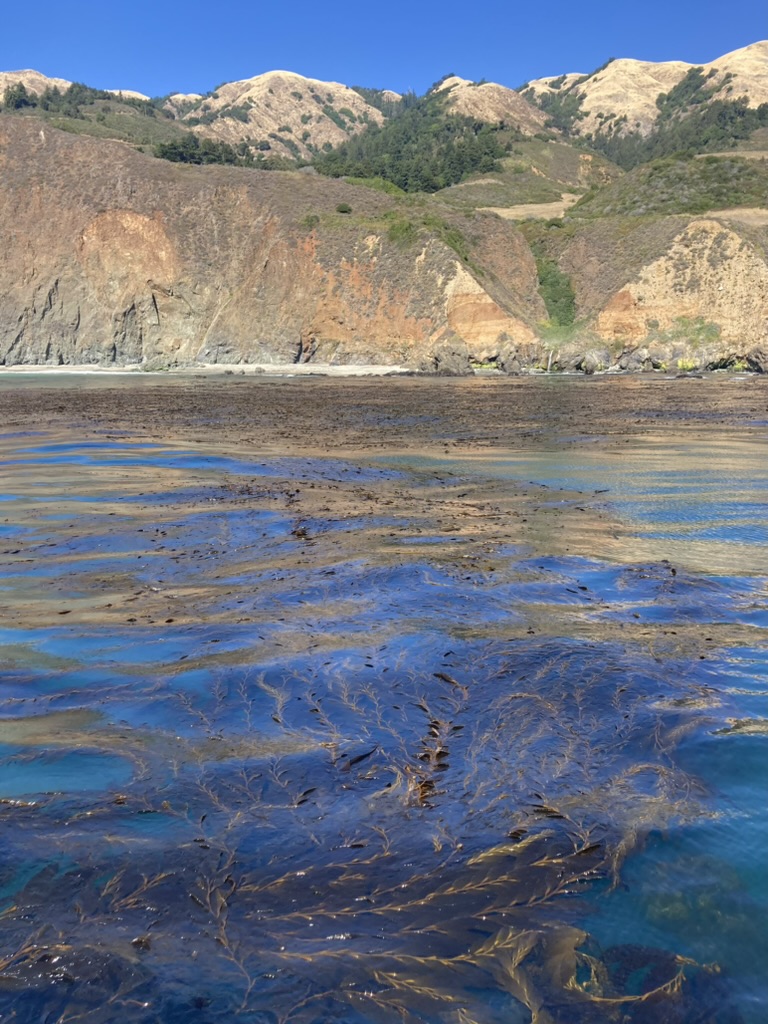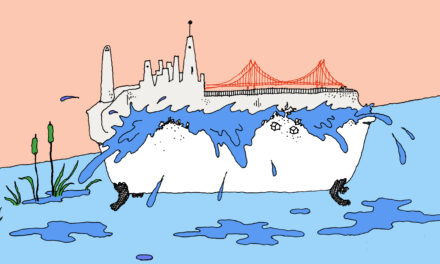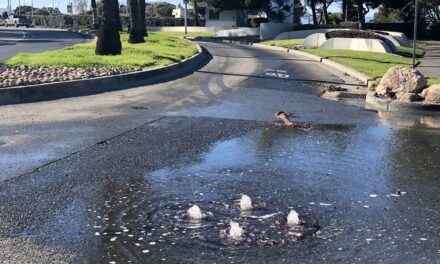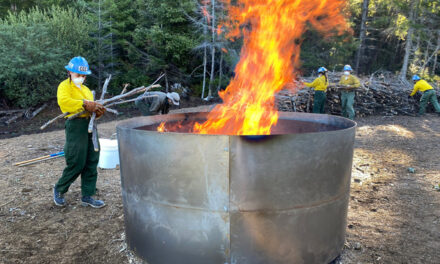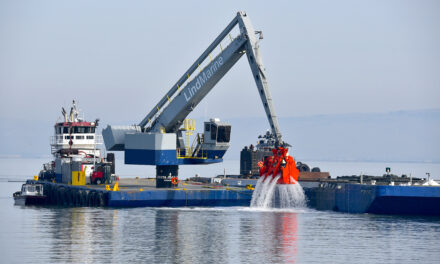Don’t Count on Kelp to Buffer the Coast
“The extent to which waves are actually affected by kelp is quite limited.”
When winter storms sent 20-foot waves barreling towards Santa Cruz, California in January 2023, the sea met none of the natural storm breaks it might have encountered on the East Coast: no crests of intricately carved coral reefs, no tangled roots of mangrove forests, no conglomerations of millions of oyster shells. Waves from the open ocean encounter fewer obstacles to sap away their energy before slamming into Californian cliff sides — and in the case of the 2023 winter storms, they gained plenty of power to toss around 8 million pounds of boulders piled against one stretch of coastal road like toys in the surf.
In the minutes before they break, California waves may roll over rocky reefs with submerged shale boulders and seafloor spires — and just before reaching the shore, they often pass through kelp forests.
For decades, the question of how much kelp forests might soften waves like other natural “blue infrastructure” was difficult to resolve. New research suggests an answer. However, efforts to understand how much (and whether) kelp can help shape California’s ocean coasts still have ground to cover, just as the stakes — and threats to the undersea forests themselves — are growing higher.
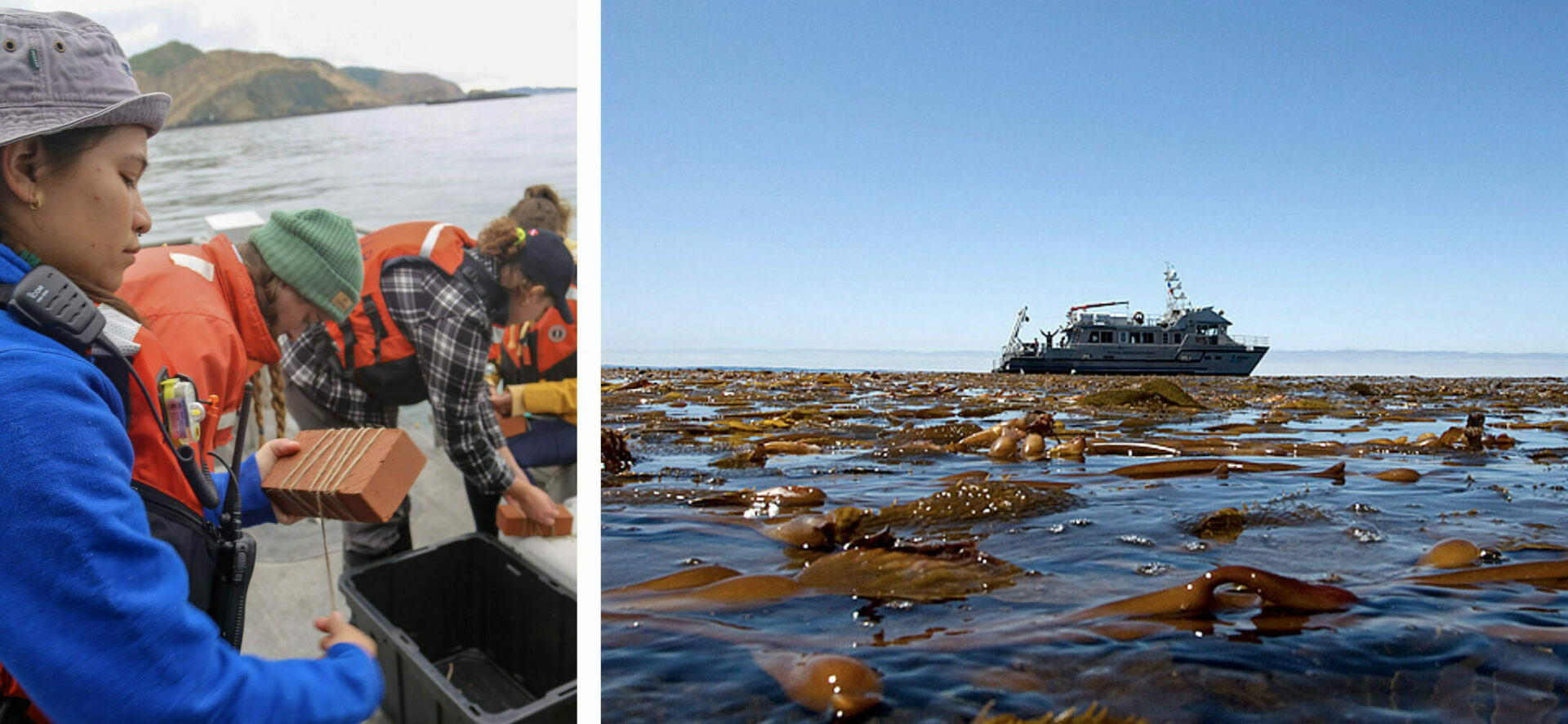
Research on kelp planting techniques in the Greater Farallones National Marine Sanctuary. Photos: GFNMS, Chad King-NOAA
The Kelp Conundrum
The intuition that kelp beds calm incoming waves has been shared by the likes of surfers, Charles Darwin, and the oral histories of many First Alaskans, whose ancestors may have arrived by boat via a “kelp highway” on the protected inner edge of the thick kelp forests that rimmed the coastline from Alaska to Baja California.
Today, research on how kelp forests could shape the ocean coasts they border is still nascent, in part because kelp forests themselves were once seen as a given: thinned out and ragged after winter storms, sometimes buffeted by El Niño cycles, but perpetually able to bounce back along the west coast of North America. While research boomed in the twenty-first century on how coastline communities were reshaped and threatened with mangrove forests ripped up for coastal development or oyster reefs dredged for shucking down to the last shell, kelp forests were considered less threatened.
That all changed a decade ago, when catastrophic cascades in kelp forest ecology along the West Coast and an intense marine heatwave conspired to wipe out hundreds of miles of kelp forests.
Warmer water favors purple sea urchins, which are now feeding on and undermining kelp forests offshore. Photo: Brandon Cole
“We know there’s boom and bust in these systems, but we hadn’t seen the mass loss like we have a couple of years ago,” explains Ryan Freedman, a research ecologist with the National Oceanic and Atmospheric Administration who recently co-authored a review of kelp’s role in coastal resilience in Alaska.
Until recently, scientists struggled to untangle how much the kelp itself could diminish the incoming waves versus the topography of the rugged, rocky bottoms where the undersea forests like to grow.
“There have been very few studies that have actually tested this in the water,” says Kristen Elsmore, a senior environmental scientist with the California Department of Fish and Wildlife. “A lot of [research] has been primarily through mathematical modeling as well as laboratory monitoring in wave tanks.”
But this year, a team of researchers led by Elsmore published results from a southern California site where a kelp restoration project was encouraging a new forest to grow. By comparing the waves’ energy passing through the site from year to year, both before and after the kelp forest existed, they were able to isolate what role the kelp itself played, and what was due to the shape of the seafloor. They found that the kelp forest itself reduced the wave energy flow by about 6-8% on average, with the kelp playing a slightly larger role when waves are under three feet tall.
“The extent to which the waves are actually affected by the kelp is pretty small and quite limited,” Elsmore says.
Mark Denny, a specialist in ecological mechanics at Stanford and one of the paper’s co-authors, is even more direct about the implications for coastal protection.
“People have floated the idea, no pun intended, of using kelps as a way of protecting shorelines. And it’s just not going to work,” he states bluntly as we gaze over a tangled giant kelp bed bobbing gently under the sun in Monterey Bay. The waves in the bay aren’t large, and only gentle ripples wrinkle the short expanse of water between the kelp and the beach. “A 10 or 12% reduction in the wave force is not going to save the shore.”
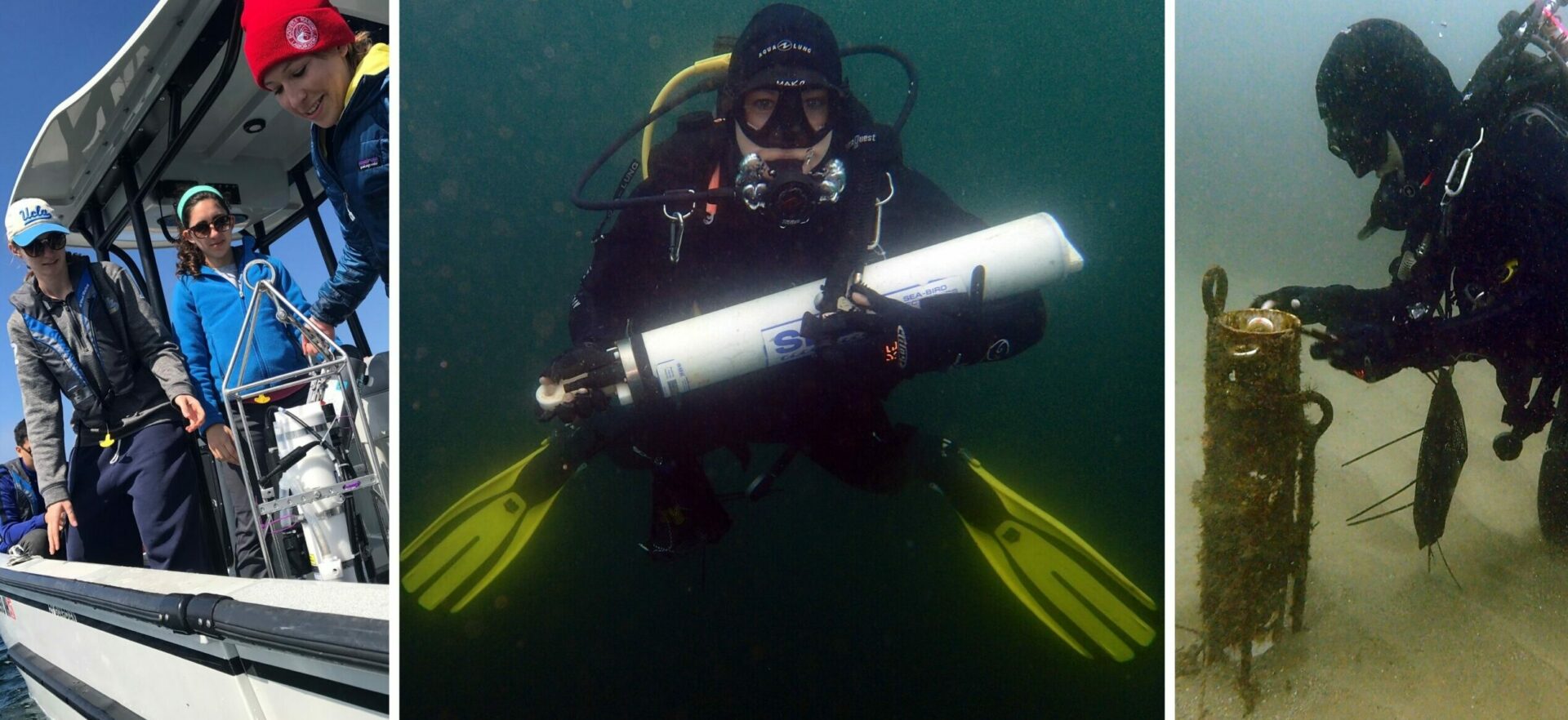
Researchers place sensors and monitoring instruments in a kelp bed in Southern California to measure hydrodynamics. Photo courtesy Heather Burdick, The Bay Foundation
Research on other submerged vegetation, like seagrasses, has shown that waves flowing over these shorter undersea pastures encounter a lot of drag as the stalks reach the end of their tether. Elsmore says the giant kelp forest in her experiment didn’t dampen passing waves very much because “by swaying and going with the motion of the waves, there’s not really a lot of opportunity for them to take on that drag…which is when they [would be] able to absorb some of that wave energy.”
Going with the Flow
More research is still needed to apply the results from the experiment along the rest of the coast.
Halfway up the California coastline, luxurious canopies of giant kelp give way to rugged northern California forests dominated by bull kelp, a separate species that Eslmore describes as looking like “a giant lollipop with pigtails.” From shore, the bulbous lollipop-heads of bull kelp can be mistaken for sea otters peeking their heads above the surf. Giant kelp grows in tangled strands of often hundreds of interlocking stalks, called stipes, and they’re buoyed upwards by gas-filled bulbs dotted across the length of the algae that resemble nutmeg-brown Christmas tree lights. The nuanced differences in the kelp species’ buoyancy, and where the bulk of their respective forests rest in the water column, may affect how water flows through them.
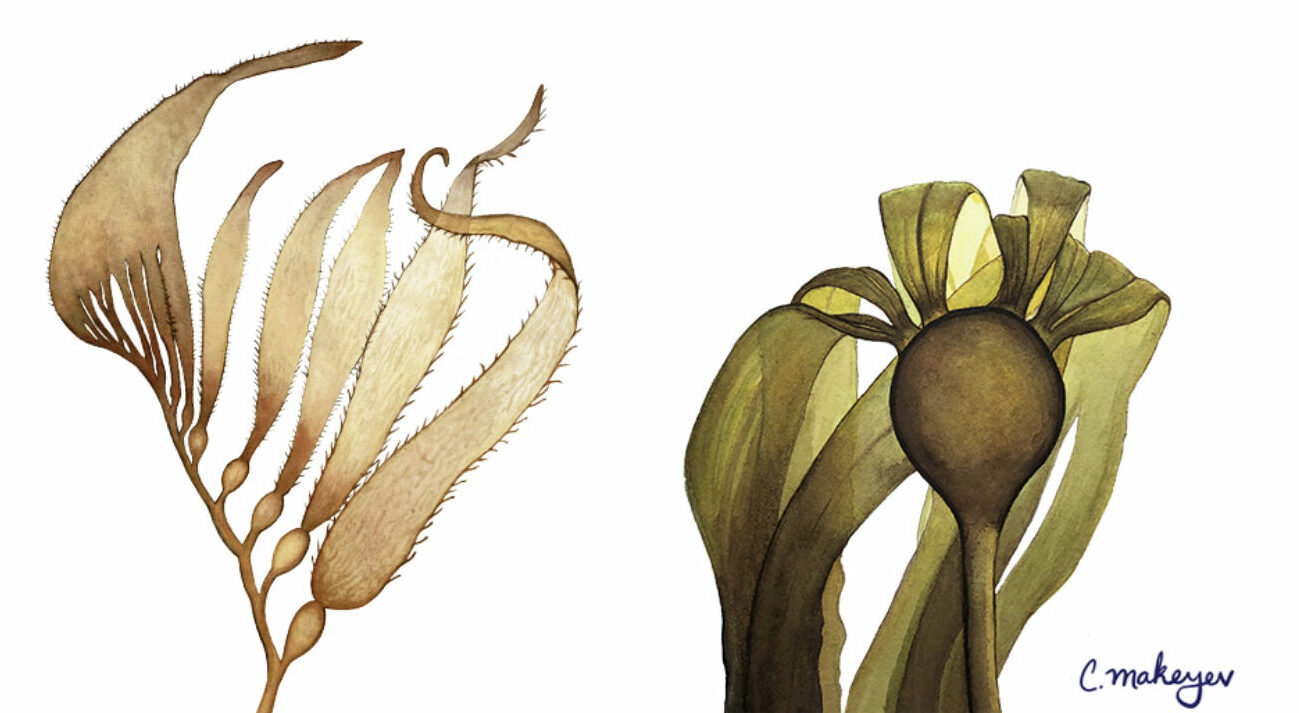
Giant kelp (left) and bull kelp (right). Illustration courtesy CDFW
It’s also unknown how kelp forests at different depths would affect waveflow. Forests can grow from less than 10 feet deep to nearly 100, and as waves approach the shore, they progress from ruffling the upper kelp canopy in deep forests to jerking the entire forest back and forth with the swell in shallower seas.
Uncharted Waters
Although Elsmore’s research is tepid at best on kelp’s ability to diminish powerful waves before they hit the shore, she emphasizes that kelp forests can shape shorelines indirectly after the powerful waves have passed, by affecting the flow of nearshore currents.
“[Kelp] does play an important role in where the sediment goes, or doesn’t go, following an erosion event,” says Elsmore.
Swimming through kelp.
That’s because after a storm, lots of sand and rocky debris remain suspended in the water. Currents affect where that sand ends up — and although kelp forests don’t dissipate much energy from waves, they’re very good at changing the speed of currents flowing parallel to the shore. As the kelp forest grew in around the sensors at the restoration site in her experiment, says Elsmore, “you actually see in the flow speed data throughout the water column where the canopy was at any given point in time, because just below the canopy, the flow speeds were significantly reduced.”
Because longshore currents deposit sand along the coastline, losing kelp forests could affect the rhythm of how sandy beaches are built up and washed away. But there’s no research yet, says Elsmore, that has tried to directly link shifts in how sand is deposited on beaches to kelp forest loss or rehabilitation.
Giant kelp. Photo: Brandon Cole
Understanding these details matters because the California Department of Fish and Wildlife is in the midst of gathering feedback about priorities for efforts to bring back giant kelp and bull kelp in areas where the massive algae have struggled to return after their ecological wipeout nearly a decade ago. Freedman emphasizes that despite the uncertainties, we already know a lot about kelp forests’ value independent of their uncertain role in shaping the coastline: they create habitats for economically important fisheries, provide dozens of recreational opportunities, and evoke powerful cultural ties for people along the entire west coast of North America. These benefits and others are more than enough to make the undersea forests worth protecting, regardless of how they shape the coastline (or don’t).
“Even if you don’t care about giant kelp as a species, people care about things that impact their livelihoods and coastlines,” he says. “If we don’t have these healthy [forests], we’re going to lose a lot of ecosystem services people care about. And wave attenuation might be one of them — we just don’t know.”
Top: Kelp is very flexible. Photo: Brandon Cole






